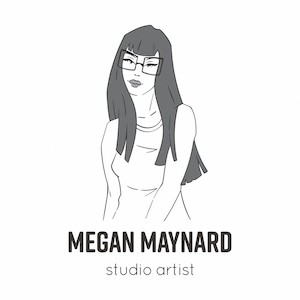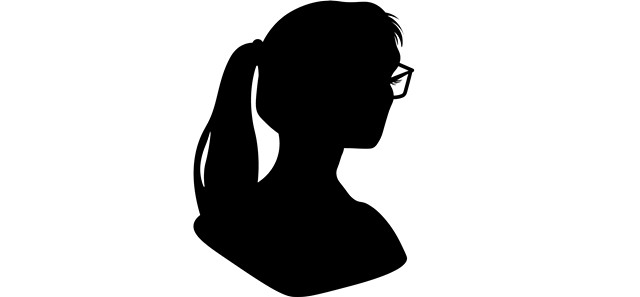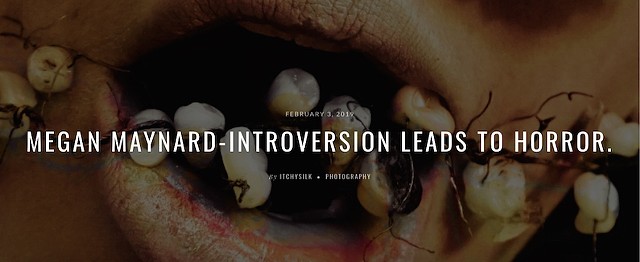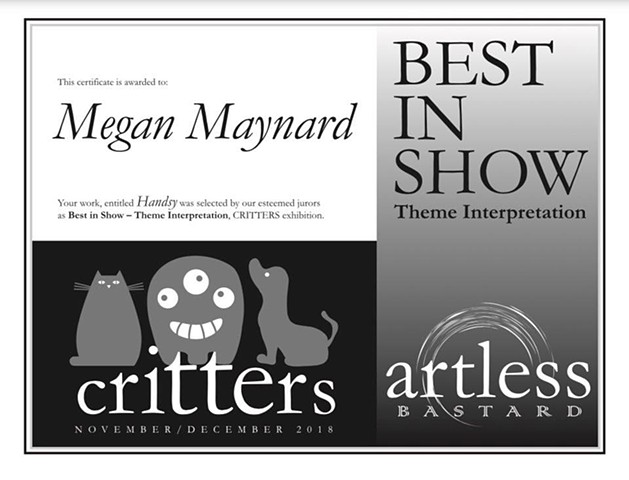Interview with Itchy Silk
Megan Maynard- Introversion Leads to Horror.
In her wish to “deconstruct reality” and encourage ‘us’ to explore our own curiosities, Indiana based photographer Megan Maynard evokes acute visceral reactions. Exploring childhood, the loss of innocence and horror, her visually uncomfortable images (at times) cause recoil. But as a viewer we need to contain that immediate reaction. The 24 year old Megan Maynard (with a background in special FX and theatre) wants us to embrace the recoil and then delve into her world of performance art and horror.Allow us to delve a bit into your childhood what was it like and how might it have shaped your path to creativity?
Growing up as an introvert I found a lot of solace in various creative endeavours. I remember exploring the hidden areas around my neighbourhood and collecting various items I found-they were usually broken. I would attempt to put these different broken items together to create something new. I also enjoyed writing short stories and dressing up to play pretend. I was always imagining different characters. A lot of them inspired by American cartoons and video games. Once I was introduced to Japanese cartoons, I started to try to draw my own characters. I was really attracted to the artwork of Anime. I did not really push my creative wishes until collegiate level.
Art can sometimes be viewed by parents as a rather unstable profession. How did your parents take to your wish?
My parents did not encourage my artistic abilities. They pushed me (with their best intentions) into other activities and interests. I only found myself turning to art more once I attended a boarding school for ‘high ability’ Indiana high school students. For different creative projects in classes, I would try to push myself artistically by exploring various drawing techniques and by giving my art the time it needed to start maturing. My teachers were very encouraging of my artistic abilities, and I strongly believe I wouldn’t have committed to the arts without their support.
Do you think your natural introversion helped/helps your art?
I’ve always been a highly sensitive person (both emotionally and physically). It was tough for me as a young child to process my ‘overwhelming’ feelings. I was extremely shy and scared of everything. I remember being in kindergarten and being extremely concerned about the structures of buildings. I envisioned a disaster with the buildings collapsing on me.
I like to think my sensitivity gives me more to experience in the world. Things are more dramatic and tragic. I instinctively pay attention to details, find patterns, and find meaning in the minutiae of everyday life. Art is essential to me. It allows me to find personal fulfillment and connect with other people. I still struggle today with social anxiety due to my sensitivity. Art however has become my way of naturally breaking down that barrier.
Discuss inspirations for your work?
Cindy Sherman with her conceptual self-portraiture (regarding my performance art/photography work, she was my biggest influence. Horror photographer Joshua Hoffine-I strongly admire his elaborate staging to create strong narratives, plus horror is awesome, and installation and performance artist Chiharu Shiota. In the future, I plan to explore creating three-dimensional installations (I love the idea of creating a 360-degree room experience for an audience).
Elaborate more on this idea taken from your artist statement- “deconstructing reality to explore my own curiosities”.
As a highly sensitive person and an introvert, I spend a lot of time analyzing and observing my surroundings. I consciously try to look at the world objectively. That includes making sure I am always looking at the bigger picture. I strongly believe that things aren’t black and white. I think it’s easy for people to assume that if they do not comprehend something, then it probably isn’t right. I reject that mentality in attempt to objectively experience reality. Photography is a vessel that has been used for documentation and ultimately visual evidence of reality. The staging element of my conceptual self-portraits and still life allow me to construct any ‘reality’. As an artist, it’s an incredibly powerful tool.
And how do you explore those ideas in your photographic work?I utilize self-dramatization through costume and sculpture in my photography in attempt to create an initial visceral reaction. I am a horror film and special FX makeup fan, which is visually represented in my photography and digital editing (with elements like blood and dark textures). Along with creating still life, I implement objects like dolls, mirrors, teeth, baby clothing, old toys, and flowers throughout my photographic work. It reminds me of the playing I did as a kid, but with much more intent. I think I’ll always remain curious-like to refer to myself as a “forever student”, (I love to learn). I hope to encourage my audience to act on their own curiosities, to not be afraid to explore the unknown.
“Performance art” in photography-why do you approach your work from that angle?
There’s a German word called maskenfreiheit that really resonates with my art: maskenfreiheit describes the freedom that comes with wearing a mask. I believe masks open the possibilities of surfacing aspects of an individual that were once hidden. As an artist, I embrace this freedom that comes with wearing masks to create different personas through costume that I utilize through performance art in photography. I had an interest in costume design during my undergraduate studies and was involved with numerous theatre productions. I really enjoyed the idea of using conceptual photography as a tool to create visual narratives, and it ultimately combined my theatre and art background by utilizing the photograph as a stage.
Your work has horror/gothic horror edge to it.
It’s funny for the association with horror/goth because when I first started creating, I just focused on what I wanted without any regard for what it would be classified as. As I began creating, I ended up falling somewhere on a spectrum between lowbrow art and dark contemporary art. My stylization is influenced by my relationship with horror films.
When I was in first grade, my family and I were watching The Ring (2002) in our basement on a home theatre-sized television (so as a small child, it was a massive screen). I fell asleep early in the film, and once it was over my family went upstairs and kept the movie on. The film replayed and I remember waking up and being frozen in fear by jarring images. I had nightmares of these well-sized holes appearing randomly throughout my childhood home and I would endlessly fall into them.
As I got older, I oddly enough started having the desire to watch more horror films, and it ultimately developed into becoming an avid fan. I was able to finally separate horror films from reality, and once I was able to do that, I started to appreciate and become interested in the behind-the-scenes production (especially the costuming and special FX makeup).
Stephen King has explored horror and childhood to global acclaim. Talk about your exploration of that synergy.I explore the loss of innocence in many of my works using widely altered but understood symbolism for children, including broken toys and corrupted dolls. I also incorporate teeth in many of my works, as losing teeth is a major milestone in the transformation from child to adult (and it’s a bit of a gruesome one at that).
I focus on the loss of innocence because it’s something that is inevitable but happens for everyone at a different rate. It’s this delicate game where learning different things about the world may do a child more harm than good.
During my undergrad, I worked with a girl around my age that suffered severe PTSD from childhood trauma. She was forced into a prostitute ring by her parents, along with her younger brothers. She struggled as an adult to eat at a normal pace because her parents would make her fight with her siblings over very limited food. It still makes me heartbroken to think about it, but I found myself thinking of the loss of innocence a lot during my time with her.
Death or the idea of death/suicide features in your work. Are we in the West too afraid of death?
We are absolutely, and understandably, too afraid of death, as it is inevitably lingering over everyone’s heads. I don’t think it’s what kills us that we are afraid of-it’s the unknown of what happens after we die. I am openly curious about death. I find myself exploring it in my works with a humorous approach hopefully lightening the mood to bring some acceptance of death.
Suicide has its own controversies, and that tends to be received more poorly in my works than death itself. I’ve been wanting to explore suicide more in my works given how serious and relevant it is in modern society; I really think we need to confront the issue more.
You state you want your audience to explore the unconventional-why?
I think it is easy for people to fear going against the conventional and taking the road less travelled in life (and I mean that in a sense of self-fulfilment). They could be afraid of the uncertainty and the unknown, or maybe they don’t want to tread on other people’s expectations. I can only imagine the amount of artless canvases and soundless songs there are from people too afraid to follow their dreams. I want to encourage my audience to be mindful of their actions; don’t be afraid to question what is generally done or believed in everyday society. Don’t be afraid to be unique, and ultimately, yourself.
"Handsy"
"Handsy" found a home in Wisconsin too! Way to be a critter.
"Summation" 2017 Senior Art Exhibition





